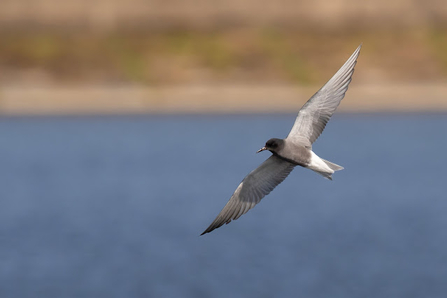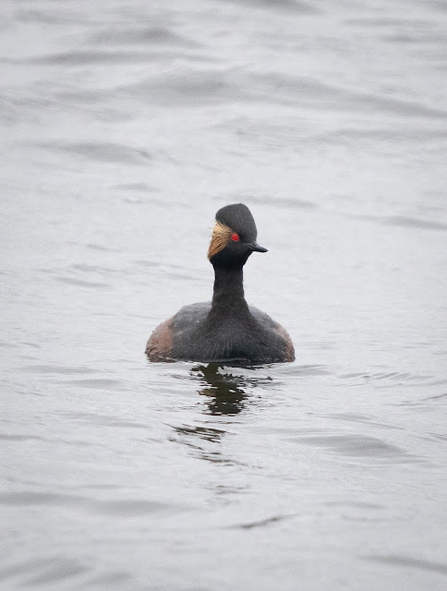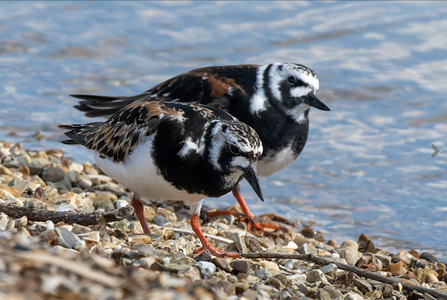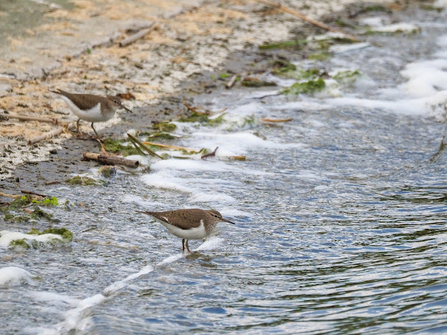May produced quality birds from the beginning to the end of the month with flocks of both sanderling and turnstone the highlights. In another blaze of colour, the month also saw black terns, black-necked grebes and garganey along with ringed plover and hobby added to the year list.

Black tern
Photo credit: @henrywynjones
These eight additions in May take the year list to 127, ten more than last year and three more than in 2021. Wigeon is - inexplicably - the big miss so far but the Wetlands might also have expected to have recorded greenshank and black redstart already. Far more serious is the fact that for the second year running Avian Flu is infecting birds at the Wetlands. This summer it is black-headed gulls and cormorants that seem worst affected.
For the second successive year, barnacle geese have hatched young on No 5. Four young were initially seen with one quickly lost but the remaining birds survived until the end of the month.They could usually be found around the No 4/5 causeway close to the trout fishermen who not only share their sandwiches but also provide some protection from marauding foxes. Another pair appeared to be trying to breed on the big island on No 5 but there has so far being no sign of any success.
Drake garganey
Photo credit: @MLP
It looked as if Spring was going to pass without any garganey being seen until MLP photographed a stunning drake on No 3 on the 24th which stayed for the day. Shoveler are often missing in May but up to four were seen from the 20th. A teal was also an unusual record for May with a drake seen for a few days in the middle of the month on No 3. After arriving in early January, the drake scaup was last seen on the 5th, the latest a wintering bird has stayed in recent years.
As the wintering Scaup departed, the breeding ducks began to produce young. The first tufted duck family were seen on the 22nd - three weeks earlier than last year - with at least a couple of pochard broods as well before the end of the month along with a gadwall family.

Black-necked grebe
Photo credit: @EugeneDH_Bass
A stunning black-necked grebe was found on Lockwood on the 12th and came so close it could be heard singing. It, or another, also appeared on East Warwick on the 28th. Two great white egrets were recorded with one flying over No 4 on the 13th and a second over Lockwood on the 27th. At least 22 little egret nests were found in the breeding survey this month. This is three down on last year's total but the team were unable to carry out a full second survey so nests may have been missed.
Red kites were seen on the 15th and 28th compared to five days last year while buzzards were slightly more frequent with records on the 13th, 14th and 28th, one more day than in 2022. Hobbies dashed over the reservoirs on the 4th, 9th, 12th and 27th.
Hobby
Photo credit: @magusphotog
May saw an excellent ten species of waders at the Wetlands with the persistent and strong northerly winds extending migration right to the end of the month. Just like last year, there was only one record of lapwing with a single on the 23rd. Oystercatchers were slightly more common with one on the 3rd, two on the 11th and one on 13th although the song thrush at the north end of Lockwood which does a wonderful imitation suggested they are passing over all the time...
Little ringed plover
Photo credit: @Chris_Farthing
The first two ringed plover of the year were seen on Lockwood on the 13th - six days later than the only record last Spring - with a single on the 22nd. Single little ringed plover were seen on the 3rd, 27th and 31st compared to no records last year. Black-tailed godwit are more normally an early Autumn bird at the Wetland but CF had the first record of the year flying over on the 3rd.

Two turnstone
Photo credit: @magnusphotog
Despite continuing high water levels, Lockwood proved attractive for waders at the end of the month as perhaps the strong northerly winds prompted them to take a breather on their passage. DW, on a weekend visit from his wardening job on the Wash, thought he was back in Norfolk when he found five superb summer-plumaged turnstone on the shingle at the north end on the 20th.
Sanderling
Photo credit: @rom_london
Sanderling had been considered a rarity at the Wetlands with records in only four years in the previous decade before five turned up together last May. But in a month when this charismatic wader seemed to drop down on lakes and reservoirs across the country, this count was surpassed. The first bird appeared in front of those watching the Black Terns on the 27th before seven - the biggest flock anyone can remember - were seen together at the south end next day. In contrast, it was a blank month for dunlin when there were four records in May last year.

Common sandpiper
Photo credit: @Elliott81758817
After poor numbers of common sandpiper in April, May was better with records right until the last day. This is 11 days later than the final Spring bird last year and three days later than in both 2020 and 2021. Another sign that migration was held up by the weather was that while the peak count of nine was the same as last year, this May it was on the 27th rather than the 1st. The only green sandpiper was seen on the 3rd, one day later than the final record last year.
Late April's nice run of arctic terns continued with singles on the 1st, 4th and 8th. With the end of the month fast approaching, it looked as if the Spring might pass without a black tern being seen until ML found three on Lockwood in full summer-plumaged on the afternoon of the 27th.
Black tern
Photo credit: @EugeneDH_Bass
There were again welcome signs that cuckoo are getting commoner with three more sightings after April's first record. Silent birds were seen on the 7th and 22nd with the wonderful sound of a male calling on the 16th. Kingfishers continued to show well with the pair nesting on the small No 5 island regularly taking fish to feed their youngsters by the month end.
While the northerly airflow undoubtedly extended wader passage at the Wetlands it didn't seem to drop many smaller migrants on the reservoirs. Small numbers of swallows continued to be seen with ten on the 4th and four still on the 15th. The last willow warbler in a good Spring for the species was on the 12th and the final whinchat on the 2nd, one day later than last year. The disappointing Spring for yellow wagtails continued with just two on the 2nd and one on the 4th the only records. Wheatear passage was light but again prolonged with singles still seen on the 25th and 30th.

Thank you to Leica Sports Optics for supporting our activities at Walthamstow Wetlands
Instagram: leicanature
Facebook: Leica.Sport.Optics
Twitter: LeicaBirding
